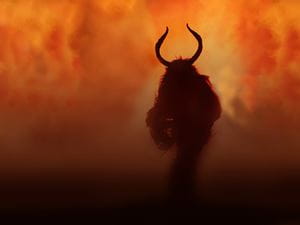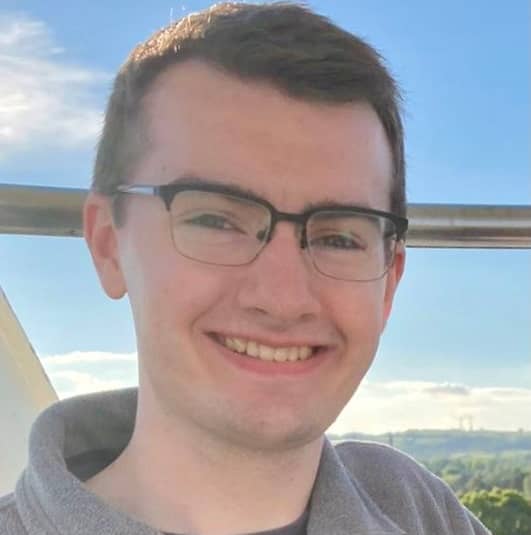
Stranger Things is an Eighties nostalgia-palooza. From neon socks to cartoon Ewoks, the series wheels out every trope in the book. Until Stranger Things 4, however, the show didn’t really tackle the decade’s theological hang-ups. And with a period so tortured with religious hysteria to mine for inspiration, the Duffer Brothers – Matt and Ross Duffer, executive producers – had ample material to hand.
Integral to the plot is a phenomenon which attained its high-water mark in the 1980s, known as the Satanic Panic. One character, new to the cast in Stranger Things 4, convinces himself – as many did, and still do – that Satan-worshippers intent on homicide are everywhere. This illusion has a major influence on the storyline, as I will explain.
We first encounter Eddie Munson, a high school student who loves heavy metal music, reading a Newsweek article, “D and D: The Devil’s Game.” Its content is typical journalistic alarmism, ‘Studies have linked violent behavior to the game,’ Dungeons and Dragons being the game in question, ‘saying it promotes satanic worship, ritual sacrifice, sodomy, suicide, and even murder.’
Eddie’s friends are social misfits, who collectively call themselves the Hellfire Club – a regrettable moniker, given the Satanic Panic – and all share a sense of ostracization. As a Hellfire member observes, those who struggle to fit into the mainstream are convenient scapegoats when there is anger to be vented, ‘Society has to blame something. We’re an easy target.’
In this one line, the Duffer Brothers foreshadow the rest of Eddie’s character arc. A cheerleader, Chrissy, gets loathsomely murdered and Eddie, sure enough, is in the frame for it. Only the murderer is, in fact, a supernatural creature which espouses the Freddy Krueger school of extermination. It eliminates its victims in their mind, which entails their death in the real world as well.
The news travels quickly. Jason, the basketball team captain who was Chrissy’s boyfriend, assumes Eddie was the killer simply because the latter has a fondness for Dungeons and Dragons, ‘I’ve read the wrong person plays this game, it can warp their mind. They confuse fantasy and reality, and innocent people die.’ When someone plays Monopoly, they generally don’t open an actual Park Lane hotel afterwards. I don’t see Jason’s logic.
It isn’t Eddie but rather Jason who labors under a fatal confusion between fantasy and reality. Therein lies the cardinal irony. Jason confuses the fantasy that Eddie’s Hellfire Club is a Satanist organization, culpable for Chrissy’s death, and the reality that Eddie has mistakenly been accused of a heinous crime.
Here we see how Satanic Panic operates. A grief-stricken boyfriend requires a cogent explanation for his girlfriend’s tragedy. Demonic involvement is a likely theory for an evangelical Christian to believe, and it’s all the more plausible because others tell similar stories to themselves. ‘I mean,’ Jason posits, ‘it’s been happening all over the country. It’s like an epidemic.’
Returning characters Nancy and Robin do their homework on paranormal killings. They find an article about a certain Victor Creel, whose case is eerily similar to Chrissy’s. ‘Victor believed his house was haunted by an ancient demon,’ the duo discover. For lack of a better theory, then, Vecna the demon is also responsible for Chrissy’s doom.
The girls essentially come to the same conclusion as Jason, that an unseen force is answerable for Chrissy’s attack, although they choose to presume Eddie’s innocence. Between them, they’ve dealt with enough otherworldly high jinx in prior seasons to know that a higher power than a mere high school nerd is afoot.
Indeed, Sam Owens – a government scientist, so not a man given to Satanic Panic – reveals Vecna to be not a demon exactly but only the latest incarnation of an evil that, since the first season, has been plaguing our protagonists. ‘Each time it returns, it comes back stronger, smarter, deadlier.’
Nancy and Robin eventually speak to the storied Victor Creel, now held in a mental asylum. He recalls how Vecna tormented his loved ones, ‘My family began to have encounters conjured by this demon,’ Victors explains, ‘This was an evil. An evil neither animal nor human. This was a spawn of Satan.’
Victor then draws on a trope of all ghost stories, ‘I suppose all evil must have a home.’ This localization of evil in a sinister abode is textbook horror. Think of Stephen King’s Marsten House and Overlook Hotel, to name some obvious examples. ‘I could sense this demon,’ Victor confesses, ‘I became convinced it was hiding, nesting, somewhere within the shadows of our home.’
Stranger Things is heavily reliant on flashbacks to flesh out its plot. And so, the viewer sees into Victor’s memory from the 1950s, where he recollects his family’s macabre demise. Predictably, Victor’s wife dies in the same exact way Chrissy did, whereas Victor survived and was locked away for murder.
Chrissy’s funeral takes place in a church. A woman, presumably Chrissy’s mother, is delivering a eulogy. ‘The devil is here,’ she warns, ‘I can feel his presence growing stronger each day. But I know Chrissy’s in heaven now, looking down at us, smiling.’ Religion is a comfort in times of loss, but also can engender paranoia that Satan’s cloven hooves are clip-clopping under our windows in the night.
Among Chrissy’s mourners is Vecna’s new prey, Patrick. As Chrissy’s mum delivers her elegy, Patrick sees, in his mind’s eye, the grandfather clock which always peals when a Vecna-victim’s end is nigh. Not even the sacred space – a church, of all places – is truly safe. And so, the lesson for those of us who profess Christian faith is to remain vigilant and strive, with God’s help, to keep our holy places holy.
This has been a tough lesson for the Church. Once a building is consecrated to the glory of God, the battle begins to keep it sanctified; it’s not a perpetual state. All sorts of abuses – financial, sexual, emotional – can profane the sanctuary. True Christians are temple guardians, who will never permit exploitative acts in God’s house.
But, as in all walks of life, the line between watchfulness and obsession is narrow. Jason’s delusions about Eddie have spiraled out of all proportion, ‘Eddie is a vessel. Just a vessel. For Satan. He’s made a pact with the devil. Now he has his powers.’ Ah, the good old Faustian pact.
As Jason pushes these false accusations ever more stridently, the sheriff convenes a townhall meeting. While he tries to reassure the concerned citizens in attendance, Jason hijacks the microphone and expounds his conspiracy theory, ‘These murders are ritualistic sacrifices. We’ve all heard how satanic cults are spreading through our country like some disease. And Eddie Munson is the leader of one of these cults.’
Another feature of religion gone bad is weaponization of scripture. We see this on display too when Jason gives his little oration, ‘Last night, I became overcome with his feeling of hopelessness. Then I remembered Romans 12:21.’ This Pauline verse reads, ‘Do not be overcome by evil, but overcome evil with good’ (NIV). Essentially, Jason has enlisted St. Paul to recruit a lynch mob and send assailants after Eddie. ‘Let us cast out this evil [Eddie] and save Hawkins together,’ Jason concludes.
Episode seven unravels Vecna’s backstory. Turns out he’s Victor Creel’s deeply troubled son, who turned his telekinetic powers on the whole family. Victor was innocent. After the murders, Vecna was held in a laboratory for several decades. Nowadays, he’s more alien than human and inhabits a parallel universe, the Upside Down, where he plots his attacks.
‘My naïve father believed it was a demon cursing them for their sins,’ Vecna scoffs. He’s a narcissist in the Freudian sense, a person who delights in his own destructive potential. Then he launches into this eldritch ode about spiders, ‘They are gods of our world. The most important of all predators.’
Vecna feels closer to these eight-legged invertebrates than his own flesh and blood, ‘They immobilize and feed on the weak, bringing balance and order to an unstable ecosystem.’ The ramblings of a homicidal maniac, like a passage in a school shooter manifesto. This is what our heroes are up against.
A scientist who conducted experiments on Vecna, Dr Brenner, knows the stakes, ‘With each victim he takes, Henry [Vecna] is chiseling away at the barrier that exists between our two worlds.’ The two worlds in question are: the familiar world of Hawkins, a small midwestern town; and the nether world of the Upside Down.
Quite reasonably, everyone apart from Vecna would rather keep the Upside Down – with all its googly-boogly horrors – at a suitable distance. Things are alright as they are, thank you very much; we can do without all those monsters in our suburb. Steven King was on the money; scary stories leave us more content with our status quo because the ghouls we see depicted onscreen betoken a far worse possibility (Danse Macabre, 316).
But it’s worse than that, ‘when One [Vecna] kills, he doesn’t simply kill. He consumes,’ warns Dr Brenner, ‘He takes everything from his victims. Everything they are and everything they ever will be. Their memories, their abilities.’ Vecna represents the cosmic plughole down which we fear all our attributes will be poured when our lives end.
I’ve digressed a little from the Satanic Panic; that’s because the show does too. Jason is back for the big finale having been absent in the series’ penultimate episode. In a nutshell, Jason obliviously meddles in a plan by the Hellfire Club and others to stop Vecna because he still thinks Hellfire is a cult under Vecna’s control.
Unfortunately, Vecna succeeds in his efforts to dissolve the boundary between Hawkins and the Upside Down. Jason gets torn in two when the portal between the two worlds opens. His conspiratorial fantasies outlive him, however, and we see the news media – true to what actually happened in the 1980s – become the mouthpiece for the Satanic Panic.
A reporter summarizes the series’ events from a sensationalistic angle, ‘Most recently, a string of high school students were killed in a series of ritualistic murders, which have been linked to a local satanic cult known as Hellfire.’ This report is read offscreen – or non-dietetically, to use a Film Studies word – while townspeople enter a Presbyterian church in droves onscreen.
The 1980s – particularly 1986, when Stranger Things 4 takes place – experienced its (un)fair share of human suffering: the Challenger disaster in Florida; the Chernobyl disaster in Ukraine; the Lake Nyos disaster in Cameroon. People the whole world over, shaken by grief upon grief, were left with a brutal question: Why?
Without an adequate answer, the default option was to blame it all on Satan, hence the Satanic Panic. I mentioned the news report read out in the series’ final episode. It invokes Hawkins as a possible microcosm for that unanswerable mystery with which our suffering confronts us: the problem of pain, as Anglican theologian C. S. Lewis called it. ‘Why their town?’ the reporter laments, ‘What have they done to deserve so much suffering?’
Stranger Things 4, though, inspires us that we have it always in our power to show courage in the face of even life’s greatest horrors. Like Viktor E. Frankl – holocaust survivor, author of Man’s Search for Meaning – in Auschwitz, we can stare down the monster and withstand it.
But what about Eddie? Well, Eddie falls in the battle for Hawkins. A poignant monologue, delivered by the lovable Dustin Henderson, reminds viewers how mistaken Jason was about Eddie. This makes us wonder how many real people got rashly condemned in the Satanic Panic. ‘I wish everyone had gotten to know him. Really know him,’ says Dustin, ‘Because they would’ve loved him.’
In summary, Stranger Things – behind all its nostalgic razzle-dazzle – makes a powerful case against our prejudices, with all their dreadful power to blind us to reality.
11/29/2022 10:17:16 PM




